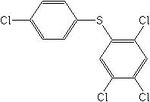Difference between revisions of "Tetrasul"
From Coastal Wiki
(→Notes) |
|||
| Line 1: | Line 1: | ||
| + | {{tocright}} | ||
{{Definition|title=Tetrasul | {{Definition|title=Tetrasul | ||
| − | + | |definition=Tetrasul, also known as diphenylsulphide, is a [[pesticide]] which was used against spider mites and aphids<ref name="IC">[http://sitem.herts.ac.uk/aeru/iupac/Reports/1275.htm#none International Union of Pure and Applied Chemistry: Pesticide Properties Database August 12 2009]</ref>. }} | |
| − | |definition=Tetrasul, also known as diphenylsulphide, is a [[pesticide]] which was used against spider mites and aphids<ref name | ||
== Notes == | == Notes == | ||
| Line 34: | Line 34: | ||
==References== | ==References== | ||
<references/> | <references/> | ||
| − | + | {{author | |
| + | |AuthorID=19826 | ||
| + | |AuthorFullName=Daphnis De Pooter | ||
| + | |AuthorName=Daphnisd}} | ||
[[Category:Coastal and marine pollution]] | [[Category:Coastal and marine pollution]] | ||
Revision as of 15:39, 20 March 2013
Notes

|
| Tetrasul |
|---|

|
| Formula |
| C12H6Cl14S |
The use of tetrasul has been banned in Europe since 2003[2].
Tetrasul has a low water solubility (0.03 mg/l) and is very hydrophobic. It therefore is very likely to adsorb to particles and the sediment and to have a high potential towards bioaccumulation.
Tetrasul becomes toxic for fishes at concentrations above 11 mg/l. As a substance witch bioaccumulates and possibly also biomagnifies there may be risks to marine mammals by secondary poisoning. Mammals which consume more than 3,9 g per kilogram of body weight might be affected. Chronic exposure might cause effects at lower dosesCite error: Invalid <ref> tag;
invalid names, e.g. too many.
Environmental standards and legislation
Included in the OSPAR list of substances of priority action
References
Please note that others may also have edited the contents of this article.
|